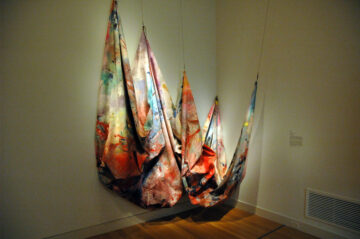Julia Bryan-Wilson at Artforum:
 SAM GILLIAM’S 1980 painting Robbin’ Peter seethes with pigment. The colors densely clot in some areas and in others are scraped flat to reveal the weave of the raw fabric canvas. Reds and blues clump and splat and drip, interrupted by short linear marks dragged through the paint to create rhythmic grooves. The work is a puzzle-like collage of previous Gilliam paintings, which have been cut up, reassembled, and glued in patchwork-quilt fashion, and in fact it takes its name from a vernacular quilt pattern known as “Robbing Peter to Pay Paul”—conventionally, a two-color needlework with curved diamond seams and overlapping, interlocked quartered circles. The pattern is found on quilts across the United States from the nineteenth century to the present day and is sometimes called simply, as Gilliam’s title acknowledges, “Robbing Peter.”1 Part of “Chasers,” a series of nine-sided works that Gilliam made between circa 1980 and 1982, pursuing in the process his always restless experiments with texture, shape, and surface, the quilt painting is muscular and assertive, pressing into space with its thick, built-up impasto excrescences.
SAM GILLIAM’S 1980 painting Robbin’ Peter seethes with pigment. The colors densely clot in some areas and in others are scraped flat to reveal the weave of the raw fabric canvas. Reds and blues clump and splat and drip, interrupted by short linear marks dragged through the paint to create rhythmic grooves. The work is a puzzle-like collage of previous Gilliam paintings, which have been cut up, reassembled, and glued in patchwork-quilt fashion, and in fact it takes its name from a vernacular quilt pattern known as “Robbing Peter to Pay Paul”—conventionally, a two-color needlework with curved diamond seams and overlapping, interlocked quartered circles. The pattern is found on quilts across the United States from the nineteenth century to the present day and is sometimes called simply, as Gilliam’s title acknowledges, “Robbing Peter.”1 Part of “Chasers,” a series of nine-sided works that Gilliam made between circa 1980 and 1982, pursuing in the process his always restless experiments with texture, shape, and surface, the quilt painting is muscular and assertive, pressing into space with its thick, built-up impasto excrescences.
more here.
